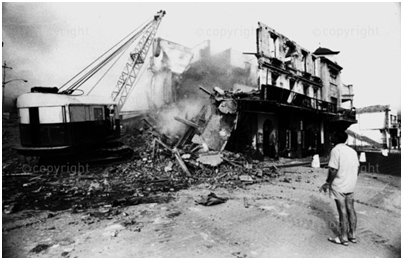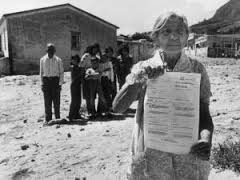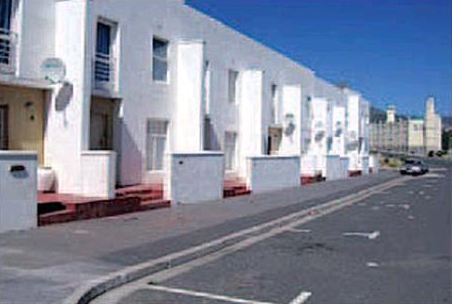
The scar on the slopes of the southern side of Table Mountain above the CBD serves as a grim reminder of that fateful day when the bulldozers rolled into District Six and by government decree, destroyed a thriving community.

February 11, 1966 is etched forever in the annuls of South Africa’s history, the day residents of the “Six” were forcibly removed from their homes and scattered across the dusty plains of the Cape Flats.
It was an emotional moment for many families and the community of District Six as a whole, the brute force of having to gather-up all they owned and leave on the back of vans and trucks; in fact any form of transport available as the bulldozers razed their homes.

In fact between 1957 and 1985, more than 150 000 Capetonians classified as non-white was forcibly removed under the apartheid government’s Group Areas Act.
Forty-nine years later, members of the once-proud District Six community returned to the area and gathered at the Homecoming Centre in Buitenkant Street where the “Cairn of Remembrance” is located, to commemorate that fateful day.
Some of these folks never recovered from the injustice, some folks grew more resilient making a life for themselves in the far reaches of the sprawling flats of the Cape, while some have returned to new homes in District as a result of a successful land claim.
For others, they were not so lucky; losing their papers in the carnage of the forced removal while some have passed on. Remaining relatives have gathered annually at the cairn vowing never to forget.

The area once known as District Six has a few new buildings but a large tract of land remains bare, a stark reminder of the destruction of a South Africa’s first township.
Notes; District Six (Afrikaans Distrik Ses) is the name of a former inner-city residential area in Cape Town, South Africa. Over 60,000 of its inhabitants were forcibly removed during the 1970s by the apartheid regime.
The area of District Six is now partly divided between the suburbs of Walmer Estate, Zonnebloem, and Lower Vrede, while the rest is undeveloped land.
The area was named in 1867 as the Sixth Municipal District of Cape Town. The District Six neighbourhood is bounded by Sir Lowry Road on the north, Tennant Road to the west, De Waal Drive on the south and Cambridge Street to the east. By the turn of the century it was already a lively community made up of former slaves, artisans, merchants and other immigrants, as well as many Malay people brought to South Africa by the Dutch East India Company during its administration of the Cape Colony. It was home to almost a tenth of the city of Cape Town’s population, which numbered over 1,700–1,900 families. (Wikipedia)
The Homecoming Centre in Buitenkant Street – The D6M Homecoming Centre is a place from which information will be disseminated, and also where visitors can experience in micro-form, some of the potential encounters possible as part of the broader District Six city experience. There will be opportunities to engage with films from the archive as well as promotional footage on the Museum, storytelling, cultural performances, to have a meal, purchase gifts and books, or lounge around and read, and in future even book tours and tickets for other partner sites. Soon Wi-Fi facilities will be available to the general public. Further research and partnerships are needed to create this vibrant space in the city. (http://www.districtsix.co.za/Content/Museum/About/HomecomingCentre/index.php )
The District Six Museum – Physical Address, 25A Buitenkant Street Cape Town, 8001, South Africa. http://www.districtsix.co.za/
For information about the Museum:-Tel/Fax: +27 21 466 7200 email: info@districtsix.co.za
Tour bookings, Visitor engagements: Zahra Hendricks, Tel: +27 21 4667200 (during office hours: Monday – Friday)
Fax: +27 21 4667210, email: reception@districtsix.co.za
Open daily – ADULTS: R30 per person (self-guided visits), R45 per person (with an ex-resident / guide), R5 per scholar (SA & African), R15 per scholar (International)
FREE ENTRANCE: – Ex-residents of District Six & other areas of forced removals; SA pensioners
The Group Areas Act – Government officials gave four primary reasons for the removals. In accordance with apartheid philosophy, it stated that interracial interaction bred conflict, necessitating the separation of the races. They deemed District Six a slum, fit only for clearance, not rehabilitation. They also portrayed the area as crime-ridden and dangerous; they claimed that the district was a vice den, full of immoral activities like gambling, drinking, and prostitution. Though these were the official reasons, most residents believed that the government sought the land because of its proximity to the city centre, Table Mountain and the harbour.
On 11 February 1966, the government declared District Six a whites-only area under the Group Areas Act, with removals starting in 1968. By 1982, more than 60,000 people had been relocated to the sandy, bleak Cape Flats township complex some 25 kilometres away.
The old houses were bulldozed. The only buildings left standing was places of worship. International and local pressure made redevelopment difficult for the government, however. The Cape Technikon (now Cape Peninsula University of Technology) was built on a portion of District Six which the government renamed Zonnebloem. Apart from this and some police housing units, the area was left undeveloped.
Since the fall of apartheid in 1994, the South African government has recognised the older claims of former residents to the area, and pledged to support rebuilding. (Wikipedia)
In Cape Town affected areas include District Six, Claremont, Constantia, Harfield Village, Steurof, Diep River, Kalk Bay, St James, Millers Point, Simonstown, Kirstenbosch, Mowbray, Plumstead, Newlands, Sea Point, Windemere and Wingfield (all Cape Town).
